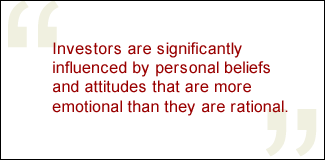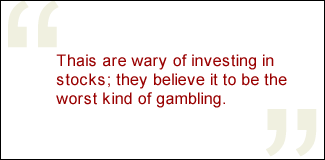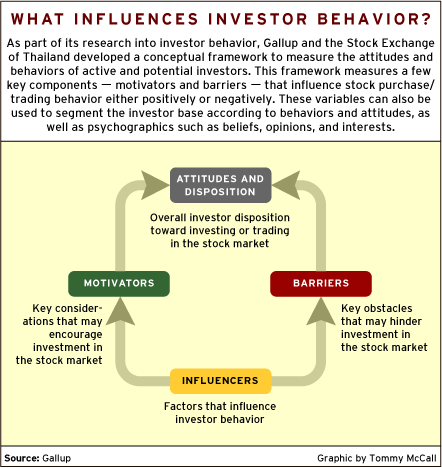Many economic and financial theories are based on the notion that when individuals make purchases, they behave rationally, carefully considering all available information before making decisions. Researchers around the world, however, are uncovering substantial evidence to the contrary. A case in point is the process of stock trading, where academic studies have documented many glaring examples of irrational behavior and repeated errors in judgment.
 |
But what are the factors that lead to such "irrational exuberance"? Why do people who are otherwise thoughtful and reasonably intelligent sometimes take appalling risks -- or make appallingly bad decisions -- when it comes to the important task of managing their investments?
Before we look at what guides investor decision-making, let's first examine the context in which this decision-making takes place. Investing is a subject of serious academic study and theorizing; understanding its core principles, strategies, and concepts is generally held to be the cornerstone of success. It's also a field populated by professionals, such as portfolio managers, many of whom come from business schools and are expected to have a familiarity with the latest research and theories related to finance, money, and savings.
When the average individual, or "retail" investor makes a decision, however, does he or she take full advantage of the extant information, knowledge, and expertise on hire? The answer, it seems, is no. What emerges from the many studies on stock trading and decision-making -- and a study of investors in Thailand in particular -- provides an intriguing profile of how people actually make financial decisions, on investments specifically, and on money matters in general.
Rather than making investment decisions using a strictly rational thought process, it appears that investors are significantly influenced by personal beliefs and attitudes that are more emotional than they are rational. This is now an emerging field of study, called "psychonomics," that integrates emotions and cognitive inconsistencies into a coherent framework to explain "investor-think" and that sheds light on the decision-making process. Psychonomic variables (similar to "psychographic" variables used extensively in the study of consumer behavior), lend themselves to more detailed analysis because they are quantifiable, enabling keener insights into the investor decision-making process.
Recently, Gallup conducted a study of investor behavior on behalf of the Stock Exchange of Thailand (SET). This research study -- the first of its kind in Thailand -- used psychonomic theory to identify and segment active and inactive investors based on their decision-making patterns.
Thailand's capital market: a turbulent history
Thailand has had its share of upheaval, triggered by the Asian economic crisis of 1997. Blame for Thailand's economic meltdown has been attributed to many factors, such as a weak currency, corrupt businesses, and the bursting of the real estate bubble. What has sometimes been overlooked, however, are the ways in which retail and institutional investors reacted to the crisis, and the part this played in deepening and perhaps accelerating it. Investor actions -- motivated by investor perceptions, beliefs, and emotions -- played their own part in throwing the already shaky market into a tailspin from which it's still recovering.
 |
Thus, the Stock Exchange of Thailand (SET) realizes only too well the importance of understanding investor behavior and its motivations. Following the regional meltdown, the SET Index -- the prime barometer of the capital market in Thailand -- plummeted to some of its all-time lows, and it has not yet fully recovered. The SET Index currently hovers around an average performance mark and still shows significant volatility. Compounding this situation is the SET's low number of trading accounts and its difficulty in attracting new investors. Most Thais are wary of investing in stocks; they believe it to be the worst kind of gambling -- high risk, and maybe high return, but meant for the idle rich who have money to throw around.
In this atmosphere, the phrase "measures to restore investor confidence" takes on heightened meaning. To revitalize the capital market and give it a new direction for growth, the SET sought to restore public faith in and attract new investors to the capital markets. To counter negative public perception regarding investing in stocks and of the capital market in general, the exchange embarked on several key initiatives. Primary among these was commissioning Gallup to help it understand the investor psyche and to develop a plan to use these insights to create strategies to significantly expand its investor base.
Building an investor model
The Gallup-SET research study was designed to better understand and explain the behavior of the Thai retail investor. The program, which began in late 2004, included a series of investigations into the capital market using a range of methodologies: qualitative diagnosis, quantitative assessment, and secondary data analysis.
The first step of the process involved extensive qualitative exploratory research. Gallup used the results, along with its experience in measuring investor behavior, to develop a conceptual framework for evaluating the attitudes and behaviors of active, potential, and inactive investors. (See graphic "What Influences Investor Behavior?") The model assumes that a potential investor's attitude towards investing in the stock exchange is influenced by many factors, including political, environmental, social, and technological ones.
 |
The model also includes important psychonomic, or attitudinal and psychographic, variables that shape investors' -- or potential investors' -- reactions to external factors, such as risk tolerance and perceptions or beliefs about shares as an investment tool. Another variable relates to investors' self-perceptions, that is, their perceptions of their ability, and competence or confidence, to trade in stocks. This aligns with key aspects of behavioral-finance theory, which not only focuses on identifying rational elements of investors' decision-making but also encompasses less tangible emotional elements, such as behavioral, attitudinal, or psychographic factors.
Relying only on models built on basic demographics -- even ones that include behaviors related to stock buying, holding, and selling -- may not help brokers gain a complete understanding of investor motivation. By incorporating psychographics as well as demographics, the model shown in the graphic provides a more sophisticated segmentation of retail investors. It gives a more complete picture of the combination of forces that act on new investors; it also sheds light on the factors shaping the perceptions, opinions, and behaviors of retail investors currently active in the capital market.
Segmenting the market
The next step in the research process involved delineating segments within its base of current active investors, as well as within the pool of potential investors. To develop a more complete picture, the study also included inactive investors, to help the exchange understand the reasons why these stock owners were not actively trading on the bourse.
The research identified five key segments among potential investors, three segments among active investors, and two among inactive investors. The segments were unique both in their behavioral profiles as well as their psychographics:
- Potential Investors: Analysis revealed five key segments: "young risk takers," "optimistic and confident," "shaky but willing," "cautious and risk-averse," and "unaware but interested." Two segments -- "young risk takers" and "optimistic and confident" -- show the most potential.
- Active Investors: Among the three key segments -- "adventurers," "cautious optimists," and "risk averse" -- the first two segments have greater potential; the "risk averse" are more fearful and tend to have small portfolios.
- Inactive Investors: Analysis revealed two key segments: "long-term investors," who are holding their stocks and waiting for the right time to maximize returns on their investments, and "quitters," who are likely to exit the market soon due to investment losses.
 |
Expanding the investment market
Once the SET understood the mindset of the retail investor, it needed to translate that understanding into action, such as developing education programs or marketing strategy targeted to new investors, the SET also needed to use these insights to investigate new product offerings and to inform its investor communications.
SET is using this segmentation to inform its strategy for expanding its investor base. The factors used to segment the market base of first-time investors, for example, were also used to leverage SET's marketing mix. These factors -- product, education, marketing and positioning -- were used, in addition to the appropriate channels, to encourage new investors to become active investors. Leveraging each element of the marketing mix is crucial to success, because if the SET's message fails to resonate with investors, they might well opt for alternative investments.
Charting a new course: refining the SET investor base expansion strategy
After the survey results were analyzed, Gallup moderated a series of educational workshops and strategy work sessions to help SET executives understand the research results. SET then formulated a strategy and developed tactics to improve its investor education and marketing activities. Gallup encouraged SET executives to focus on the most important influencers of potential investors' attitudes towards shares as an investment option: emotional considerations, or behavioral, attitudinal, or psychographic factors. These factors determine how "ready" individual investors may be to begin investing in shares. SET's carefully segmented marketing strategies for its marketing mix of product, position marketing, and education are crucial for these conversions.
The workshops and work sessions sought to answer these key questions:
- SET Product Strategy: What equity product best fits each segment? How should product benefits be communicated to each segment?
- SET Positioning Strategy: What strategy and tactics are needed to enhance SET's positioning, image, and relevance?
- Investor Education Strategy: What educational activities does the SET need to take for each segment? What content needs to be included in the curriculum?
- Investor Marketing Strategy: What activities, events, or promotions would educate as well as attract current and potential investors?
After prioritizing the ideas and activities, SET executives created "segment leverage plans" (SLPs). The SLPs detailed the marketing or promotional activities directed toward each segment in three key areas: marketing, education, or product. Teams meet regularly to discuss their progress and assess the impact of these action plans.
SET has launched activities and programs to attract more investors to the capital markets. Again, these activities are tailored for they key segments. For example, activities for young adults, such as competitions and stock trading simulation games or orientation seminars about the capital markets, have helped establish SET's new strategy to "catch 'em young."
For mature investors, SET introduced forums and exhibitions that focus on the technical aspects of investing in the stock markets. Each well-defined segment today has a unique strategy and a long-term action plan designed to tap its potential. Broad-based communication and outreach programs, like the "SET in the City" events, were aimed at providing investor education in a entertaining format. SET also reworked its "one-size-fits-all" programs into programs that cater to the needs and expectations of different investor segments.
Since the new marketing strategy has been implemented, SET has registered rising interest in the country's capital markets. In the financial year 2005, the SET investor base has increased considerably, signaling greater inflow of capital into the markets -- an important consideration that could fuel growth in a somewhat buoyant market. The bond markets in Thailand today look better than ever, while new products like futures and derivatives are likely to pave the way for greater economic growth.
The future for the Thai capital markets now looks clearer and brighter, thanks to the SET's improved understanding of the Thai investor. The SET's proven results are the result of focused activity, based on a solid understanding of "investor-think."
|
Learn More The information in this paper was initially presented on Monday, 20 March 2006, at the Asia-Pacific conference sponsored by ESOMAR in Mumbai, India, 19-21 March 2006. |